
ST. CHARLES
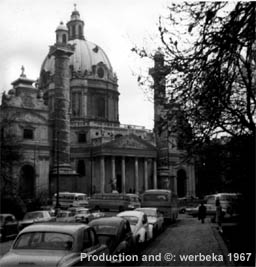 When I was in my teens, I developed my own photos. In black and white only, of course, but it was great fun anyhow, to be able to adjust the images, or to enlarge them and watching them appear on the paper. The image to the right is such a picture, today it is several decades old. The thought of having taken a "historical" photo is both fascinating and frightening. So much time has passed since then....
When I was in my teens, I developed my own photos. In black and white only, of course, but it was great fun anyhow, to be able to adjust the images, or to enlarge them and watching them appear on the paper. The image to the right is such a picture, today it is several decades old. The thought of having taken a "historical" photo is both fascinating and frightening. So much time has passed since then....
Still, the church ist more than seven times older than that. I had always thought, that the church was named after Emperor Charles VI, the father of Maria Theresa, who had given the order to build it. But its name is really St. Charles Borromeo-church, built in honour of the Saint with this name, protector of the plague. Charles VI promised to build the church in the year 1713, when the plague terrified Vienna for the seventh time in twenty years. Two years later, the great architect Johann Bernhard Fischer von Erlach started the construction of the church, a task fullfilled by his son, a little more than a decade later.
|
|
Eyecatching is the architectural jointment of different cultures, which the genius Fischer von Erlach accomplished. The small towers at each side remind us of oriental pagodas. The two high columns, flanking the greek portal, refer partly to islamic minarets, partly to Roman triumphal columns, which is underlined through the relief, showing scenes from the life of Charles Borromeo.
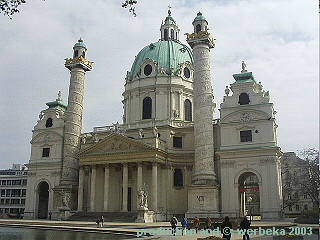 I think it is important to remember where the church was built, in reference to the city, in the 17th century. Today it has been integrated into the structure of the city, even if its position in recent years has been stressed, through the park and the pond in front of it.
I think it is important to remember where the church was built, in reference to the city, in the 17th century. Today it has been integrated into the structure of the city, even if its position in recent years has been stressed, through the park and the pond in front of it.
But about 300 years ago the church was situated outside of the city, which had its boundaries within the city walls. They stood in the approximate location of the Ringstraße of today. Outside the city walls there was an open area, the "glacis", which should make it possible to have an open view over attacking forces. In other words, there was free sight from the city itself to the church - and this sight increased its characteristics even more. There was even a thought of building a magnificent avenue from the "Kärntner Tor" in the city walls to St. Charles, but this project was never carried out.
|
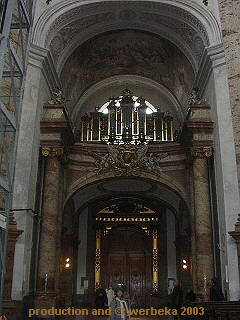 |
Indoors of St. Charles you are impressed by the overwhelming oval space, which is limited by the organ loft at the backside and in the front by the main altar, which is just another example of Fischer von Erlachs phenomenal architecture. Just look at how the light falls in from above and in that way quite naturally shows the difference between the heavenly surroundings and the dark existence on our earth. |
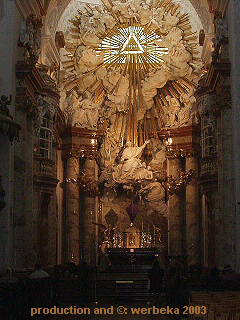 |
In between there is Charles Borromeo, sitting on a cloud, being lifted up to heaven.
But the climax of my visit today is something entirely different. Right now the frescos in the dome, rising at a height of 45 meters, are being restored. To be able to do this, there has a scaffold been erected in the middle of the church and along with it a lift, in which visitors can ascend about 30 meters.
|
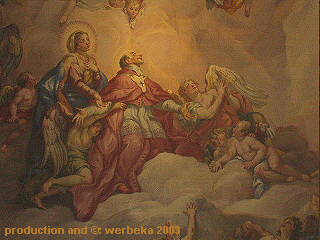 This is of course a wonderful occasion to have a close look at the artwork, done by Johann Michael Rottmayr, which normally is far to high from the ground, to be seen in detail. The artist started this work when he was seventy, working on it until his death, five years later.
This is of course a wonderful occasion to have a close look at the artwork, done by Johann Michael Rottmayr, which normally is far to high from the ground, to be seen in detail. The artist started this work when he was seventy, working on it until his death, five years later.
The main theme is Saint Charles, dressed in his red cardinal-mantle, praying to his God, supported by Virgin Mary, begging for an end of the plague's harvest on Earth. Around this main group there are angels, not at least archangel Michael with his sword. There are three other themes to be seen, allegories of the three divine virtues, faith, hope and love.
|
|
Click the images below, to enlarge them.
|
Back to  or to the or to the  of of 
5.6.2003 by webmaster@werbeka.com
|

